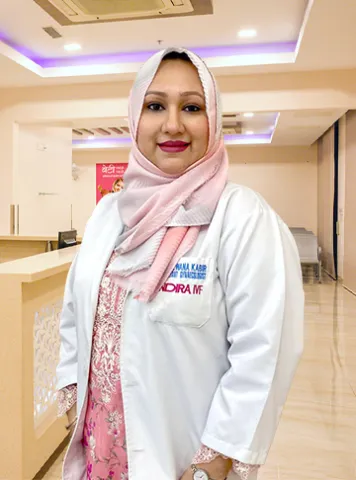What is IVF?
IVF (In-vitro Fertilisation) is a treatment for infertility in which an egg is fertilised with sperm within a lab environment. The developed embryo is observed and subsequently implanted into the uterus for possible implantation. IVF is suitable for numerous types of infertility issues; however, the strategy for IVF varies significantly based on an individual’s medical, mental, and physical conditions.
What is unique about IVF is its adaptability. With advanced technology and individualised protocols, IVF can be designed to address a diverse range of fertility difficulties.
Why IVF Might Be the Right Step Forward?
Fertility is very personal, and everyone's experience is different. IVF provides a science-supported, humane solution when natural conception isn't going as planned. You may want to consider IVF if :
- You've tried for a year (or six months if you're over 35) and haven't conceived.
- You've got known reproductive issues such as blocked tubes, endometriosis, or low ovarian reserve.
- Male factor problems (Low sperm count or other male infertility issues) exist.
- You've experienced recurrent miscarriage or unexplained infertility.
- Other treated techniques, such as IUI, have not succeeded.
IVF Isn’t One-Size-Fits-All: Exploring the Many Paths to Parenthood
With advancements in technology, fertility treatment is also picking up pace by providing more than a single form of IVF. Here is a list of the primary forms of IVF—each individually suited to particular needs and conditions :
Conventional IVF :
This is the classic approach of IVF treatment, which includes stimulating the ovaries to release multiple eggs, which are subsequently fertilised in the laboratory. After viable embryos are formed, one or more are implanted in the uterus during the same or subsequent cycle. The method is best for :
- General infertility patients
- First-timers for IVF
- Individuals with sufficient ovarian reserve
Natural Cycle IVF :
The method of natural cycle IVF depends on the natural menstrual cycle. This means a single egg naturally released with a menstrual cycle is harvested and fertilised in a lab setting. Ideal for :
- Hormone-sensitive patients
- Patients with poor ovarian reserve
- Drug-free treatment preference
The benefits of this method are that it does not require any hormone stimulation or extensive intervention in the body.
Fresh Cycle IVF :
In this method, embryos are directly transferred to the uterus in the same cycle as egg collection is done. Frozen embryos are not used. Major features of a fresh IVF cycle are :
- Longer procedure
- Embryo transfer when it is best for the uterus
- Can be employed for initial attempts
Frozen Embryo Transfer (FET) :
As the name suggests, this method utilises the frozen embryos from a previous IVF cycle in the ongoing one. This technique is helpful :
- If a new transfer isn't perfect
- For spacing pregnancy dates
- To save embryos for later
Elective Single Embryo Transfer (eSET) :
This method is particularly used to avoid multiple pregnancies at once. In this, only one high-quality embryo is transferred to the uterus. This type is best for :
- Younger patients
- Those with good-quality embryos
- Anyone looking to reduce pregnancy risks related to multiple pregnancies.
Double Embryo Transfer (DET) :
In this, two embryos are implanted rather than one, which can raise the possibility of pregnancy. However, the method has a high potential of resulting in the fertilisation of twins or multiple pregnancies. Considering the risk, this approach is not widely used, but can be ideal for :
- Older adults
- Previous IVF failure cases
- When the quality of embryos is subpar
IVF with ICSI (Intracytoplasmic Sperm Injection) :
This is a highly advanced type of IVF, where a sperm cell is injected directly into an egg to aid fertilisation, especially in the case of male infertility. The method is specifically useful when there is a :
- Low count of sperm or low motility of sperm
- Unexplained fertilisation failure in previous IVF cycles
IVF with PGT (Preimplantation Genetic Testing) :
PGT enables screening embryos for genetic defects before transfer to avoid the risk of any chronic disorder in the child. There are three forms of PGT :
- PGT-A : Screens for chromosomal imbalances
- PGT-M : Screens for single-gene disorders
- PGT-SR : Screens for chromosomal rearrangements
This method of IVF is generally recommended to patients with:
- Genetic disorders
- Recurrent miscarriage
- Older maternal age
IVF with Laser-Assisted Hatching :
This method helps the sperm to penetrate the egg with ease by gently applying laser thinning or making an opening in the embryo's shell to facilitate implantation. The technique is particularly beneficial for :
- Multiple failed IVF attempts
- Age-related fertility situations
- Thickly shelled embryos
Endometrial Receptivity Analysis (ERA) :
It is not a proper IVF type, but rather a diagnostic tool used to identify the optimum time for embryo transfer as per the receptivity of the uterus naturally. This tool is ideal for :
- Those who have had multiple embryo transfer failures
- Those in situations where the timing has some impact on implantation
- Those who want tailored embryo transfer timing
Ovarian Rejuvenation with PRP :
PRP (Platelet-Rich Plasma) therapy consists of injecting a patient's own plasma into the ovaries in order to aid in the regeneration of eggs, eventually helping to assist IVF. Although still experimental, this method may be offered in cases like :
- Low ovarian reserve
- Early menopause
- Repeat IVF failure
Conclusion
IVF these days is an active, individualised journey. The existence of all these different treatment options means that fertility specialists can devise personalised plans that address the unique needs and issues of every individual. Whether it's a natural cycle or a sophisticated approach such as PGT or ERA, these advances provide hope and flexibility. Understanding is the initial step toward making educated choices, and knowing these types of IVFs prepares you to ask the appropriate questions and feel empowered during your fertility journey.
FAQs
Is fresh embryo transfer superior to frozen?
Why is eSET safer?
How does ERA differ from other IVF tests?
What is the role of PRP in IVF?
Can Laser-Assisted Hatching enhance my possibilities?
Meet Top Fertility Specialists in Bangladesh at Indira IVF

Dr. Umme Ruman
Chief Infertility Specialist, MBBS(DU), FCPS(Obstetrics and Gynaecology), Fellowship in Assisted reproduction
Dr. Umme Ruman is a BMDC-registered infertility specialist based in Dhaka. She holds advanced qualifications in assisted reproductive techniques, sexual and reproductive medicine. Dr. Ruman serves as a Chief Consultant at Indira IVF Dhaka, helping patients with personalised fertility care based on her vast experience and expertise. Her knowledge and compassion will support couples navigating reproductive health challenges and guide them effectively towards their parenthood dreams.

Dr. Rezwana Kabir
IVF specialist, MBBS (SSMC), MS (Obstetrics and Gynaecology), Fellowship in Assisted reproduction
Dr. Rezwana Kabir is a BMDC-registered specialist in obstetrics and gynaecology, and now a part of Indira IVF’s team of fertility specialists in Bangladesh. She combines medical proficiency with a patient-centric approach, offering tailored solutions to couples seeking fertility assistance. She is committed to helping individuals confidently navigate the journey to parenthood through ethical, empathetic, and evidence-based care.
.


